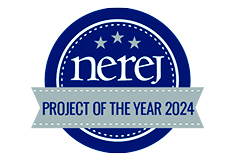News: Spotlights
Posted: January 28, 2009
Going green - It's more than just recycling paper! It is about the little things. It's a mindset.
To implement green strategies successfully at the business level, companies need to have buy-in from all levels of their organizations. Once the idea of going green becomes a reality at an internal level, a company can then begin to measure the success of its green initiatives, which eventually leads to selling points for customers and business partners. You have to "walk the walk" to effectively sell green technologies to clients, particularly in these challenging economic times.
Walking the walk is just what employees at Suffolk are doing. The principles of going green are integrated into our culture at every level of the organization, and momentum has been building across the company for the past couple of years to embrace green business practices in our offices. For example, in our Boston headquarters, interior renovations have been ongoing this past year, providing a great opportunity for us to implement green building practices. All new carpeting and all paint used during construction has been low in volatile organic compounds (VOCs), and we have installed automatic light switches in all renovated office space.
However, renovations to our offices are just the tip of the iceberg. To further promote internal green business practices, Suffolk developed a LEED National Committee, comprising employees from all levels of the company, to research effective sustainability practices and brainstorm ways for field and office employees to participate in our "Going Green" campaign.
Our internal "Going Green" campaign encourages employees to offer suggestions in our everyday business practices that will lead to a more sustainable business. We have been working hard to make those changes. In Boston, we made the switch to biodegradable plates and napkins in our in-house café, reduced the amount of paper used by distributing building plans on CDs and encouraged employees to refrain from printing e-mail messages. From simply using a washable coffee cup to seeking out office supply vendors that share the same passion for recycling, every little change made internally has contributed to measurable reductions in waste and energy.
Suffolk is also ensuring that all new staff members are educated on green building practices and LEED standards. At our Red & Blue University, training programs have emphasized LEED accreditation courses for a number of years. All new employees are required to participate in a LEED overview, and Red & Blue University is offering a three-day LEED accreditation program every month with the goal of having 25% of staff LEED-accredited. So far, we have more than 85 LEED-accredited professionals across all disciplines, including estimating, project management and in the field. We also actively use our LEED training initiatives as a recruiting tool, attracting new talent who are not only conscious about green building practices, but also are seeking out training and accreditation to further their careers.
By demonstrating leadership in the industry and creating an internal green culture, we are raising awareness of the importance of being environmentally friendly in how we conduct business and how we build buildings. Our project teams have been on the forefront in reducing material waste on our projects as a result of comprehensive planning and the minimization of waste factors. The result? At least 75% of all waste on our job sites is recycled.
Our Learning and Development initiatives have also helped to develop a new generation of "green builders" equipped with the knowledge to develop innovative sustainable solutions for our clients. Our teams are also investigating new technologies that are less common in commercial construction, such as alternative fuel sources like solar, wind, geothermal, and fuel cells.
Going green is about raising awareness and encouraging participation by all employees through training and accreditation opportunities. Going green is also about developing creative solutions for clients that produce sustainable buildings, add value to the construction process and make a positive impact on the environment. In today's environment, going green isn't just about recycling paper and turning the lights out when you leave the office—it is a mindset that must be integrated into contractor corporate cultures and shared with clients and partners who may not yet be convinced of its benefits and value.
Michael DiNapoli is general manager at Suffolk Construction Co., Boston, Mass.
Tags:
Spotlights
MORE FROM Spotlights
The New England Real Estate Journal presents the First Annual Project of the Year Award! Vote today!
The New England Real Estate proud to showcase the remarkable projects that have graced the cover and center spread of NEREJ this year, all made possible by the collaboration of outstanding project teams. Now, it's time to recognize the top project of 2024, and we need your vote!







.png)
